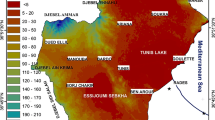Abstract
This paper investigates the potential of Spartan spatial random fields (SSRFs) in real-time mapping applications. The data set that we study focuses on the distribution of daily gamma dose rates over part of Germany. Our goal is to determine a Spartan spatial model from the data, and then use it to generate “predictive” maps of the radioactivity. In the SSRF framework, the spatial dependence is determined from sample functions that focus on short-range correlations. A recently formulated SSRF predictor is used to derive isolevel contour maps of the dose rates. The SSRF predictor is explicit. Moreover, the adjustments that it requires by the user are reduced compared to classical geostatistical methods. These features present clear advantages for an automatic mapping system. The performance of the SSRF predictor is evaluated by means of various cross-validation measures. The values of the performance measures are similar to those obtained by classical geostatistical methods. Application of the SSRF method to data that simulate a radioactivity release scenario is also discussed. Hot spots are detected and removed using a heuristic method. The extreme values that appear in the path of the simulated plume are not captured by the currently used Spartan spatial model. Modeling of the processes leading to extreme values can enhance the predictive capabilities of the spatial model, by incorporating physical information.




Similar content being viewed by others
References
Abramowitz M, Stegun IA (1972) Handbook of mathematical functions. Dover Publications, New York
Diggle PJ, Tawn JA, Moyeed RA (1998) Model-based geostatistics. Appl Stat 47(3):299–350
Dubois G, Galmarini S (2005) Spatial interpolation comparison (SIC) 2004: introduction to the exercise and overview on the results. In: Dubois G (ed) Automatic mapping algorithms for routine and emergency monitoring data: Spatial Interpolation Comparison 2004. EUR 21595 EN, Office for Official Publications of the European Commission, Luxembourg, pp 7–18
Elogne SN, Hristopulos DT (2006a) On the inference of spatial continuity using Spartan random field models. http://www.arxiv.org/math.ST/0603430
Elogne SN, Hristopulos DT (2006b) On the estimation of the nugget effect in Geostatistics based on the Spartan spatial random fields (in preparation)
Elogne SN, Hristopulos DT (2006c) Geostatistical applications of Spartan spatial random fields. In: Proceedings of the 6th international conference on geostatistics for environmental applications, Rhodes, Greece, Springer, Berlin (forthcoming)
EUR (2005) Automatic mapping algorithms for routine and emergency monitoring data. In: Dubois G (ed) Report on the Spatial Interpolation Comparison (SIC2004) exercise. EUR 21595 EN, Office for Official Publications of the European Commission, Luxembourg
Hristopulos DT (2003) Spartan Gibbs random field models for geostatistical applications. SIAM J Sci Comput 24:2125–2162
Hristopulos DT (2005) Numerical simulations of Spartan Gaussian random fields for geostatistical applications on lattices and irregular supports. J Comput Methods Sci Eng 5(2):149–164
Hristopulos DT (2006a) Spartan spatial random field models inspired from statistical physics with applications in the geosciences. Physica A Stat Mech Appl 365:211–216
Hristopulos DT (2006b) Approximate methods for explicit calculations of non-Gaussian moments. Stoch Environ Res Risk Assess 20:278–290
Hristopulos DT, Elogne SN (2006a) Analytic properties and covariance functions of a new class of generalized Gibbs random fields, http://www.arxiv.org/cs.IT/0605073 submitted to IEEE Trans Inform Theor
Hristopulos DT, Elogne SN (2006b) Fast spatial prediction from inhomogeneously sampled data based on generalized random fields with Gibbs energy functionals: http://www.arxiv.org/physics/0609071
Hristopulos DT, Mertikas SP, Arhontakis I, Brownjohn JS (2006) Using GPS for monitoring tall-building response to wind loading: filtering of abrupt changes and low-frequency noise, variography and spectral analysis of displacements. GPS Solut. doi: 10.1007/s10291-006-0035-7
Marchant BP and Lark RM (2004) Estimating variogram uncertainty. Math Geol 36(8):867–898
Matheron G (1963) Principles of geostatistics. Econ Geol 58:1246–1266
Olea RA (2006) A six-step practical approach to semivariogram modeling. Stoch Environ Res Risk Assess 20:307–318
Patil GP, Modarres R, Myers WL, Patankar P (2006) Spatially constrained clustering and upper level set scan hotspot detection in surveillance geoinformatics. Environ Ecol Stat 13:365–377
Press WH et al (1997) Numerical recipes in Fortran 77, vol 1. Cambridge University Press, London
Rue H (2001) Fast sampling of Gaussian Markov random fields. J R Stat Soc B 63(2):325–338
Rue H, Held L (2005) Gaussian Markov random fields: theory and applications. Chapman and Hall/CRC, London/Boca Raton
Rue H, Tjelmeland H (2002) Fitting Gaussian Markov random fields to Gaussian fields. Scand J Stat 29:31-49
Stein M (1999a) Interpolation of Spatial data, some theory for kriging. Springer, New York
Stein M (1999b) Predicting random fields with increasing dense observations. Ann Appl Prob 9(1):242–273
Stöhlker U, Bleher M, Thoma J, Harms W (2005) Fachliche Weiterentwicklung des Bfs-Radioaktivitätsmessnetzes: Nachweisbarkeit auch kleinräumiger erhöhter, unfallbedingter Umweltkontamination, Bundesamt für Strahlenschutz, 38226 Salzgitter
Wackernagel H (2003) Multivariate geostatistics. Springer, Berlin
Yaglom M (1987) Correlation theory of stationary and related random functions, vol I. Springer, New York
Acknowledgments
This research is supported by the European Commission, through the Marie Curie Action: Marie Curie Fellowship for the Transfer of Knowledge (Project SPATSTAT, Contract No. MTKD-CT-2004-014135), and co-funded by the European Social Fund and National Resources (EPEAEK-II) PYTHAGORAS.
Author information
Authors and Affiliations
Corresponding author
Rights and permissions
About this article
Cite this article
Elogne, S.N., Hristopulos, D.T. & Varouchakis, E. An application of Spartan spatial random fields in environmental mapping: focus on automatic mapping capabilities. Stoch Environ Res Risk Assess 22, 633–646 (2008). https://doi.org/10.1007/s00477-007-0167-5
Published:
Issue Date:
DOI: https://doi.org/10.1007/s00477-007-0167-5




